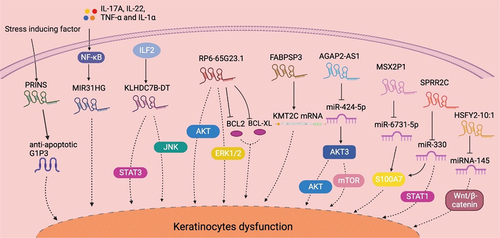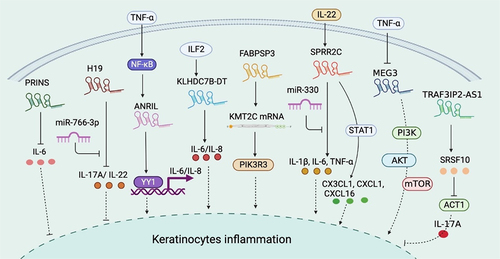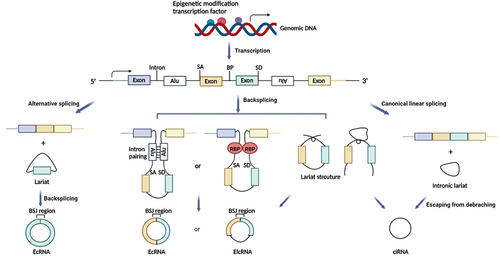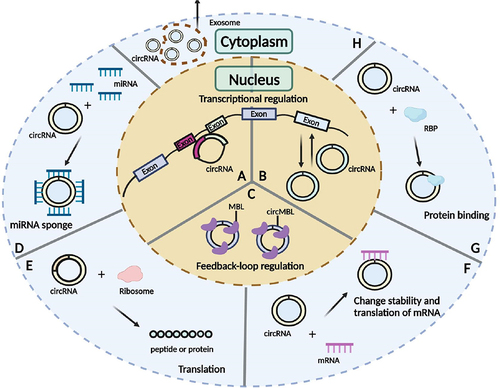Figures & data
Table 1. Summary of the currently studied lncRnas in psoriasis.
Table 2. Psoriasis susceptibility lncRnas.
Figure 1. Summary of lncRNA-mediated mechanism that contributes to keratinocyte dysfunction. The stress-induced psoriasis susceptibility-associated gene PRINS promotes keratinocyte proliferation by enhancing the expression of the anti-apoptotic protein GIP3. The NF-κB signaling-dependent expression of MIR31HG directly contributes to keratinocyte proliferation. KLHDC7B-DT, which is induced by ILF2, promotes keratinocyte proliferation by activating the STAT3–JNK pathway. RP6-65G23.1 promotes keratinocyte proliferation by activating the ERK and AKT signaling pathways while inhibiting apoptosis by inactivating Bcl2 and Bcl-xl. FABPSP3 enhances keratinocyte proliferation by maintaining KMT2C mRNA stability. AGAP2-AS1 activates the AKT–Mtor pathway by acting as a ceRNA to AKT3 by sponging miR−424-5p. MSX2P1 acts as a ceRNA to S100A7 by competitively binding to miR−6731-5p, thereby accelerating keratinocyte proliferation. SPRR2C promotes keratinocyte proliferation by sponging miR−330 and activates STAT1 and S100A7 expression. HSFY2–10:1 contributes to keratinocyte proliferation by binding with miR−145, which inhibits cell proliferation and promotes apoptosis by regulating the Wnt–β-catenin signaling pathway. AKT: AKT serine/threonine kinase 1; ceRNA: competitive endogenous RNA; ERK: extracellular regulated kinase; ILF2: interleukin enhancer binding factor 2; IL−17A: interleukin 17A; JAK: Janus kinase; KMT2C: lysine methyltransferase 2C; mTOR: mechanistic target of rapamycin kinase; NF-κB: nuclear factor κB; PRINS: psoriasis susceptibility-related RNA gene induced by stress; STAT: signal transducer and activator of transcription; TNF-α: tumor necrosis factor α.

Figure 2. Summary of lncRNA-mediated mechanism that contributes to keratinocyte inflammation. PRINS targets IL6 mRNA to suppress inflammation. H19 reduces the expression of inflammatory cytokines such as IL−17A and IL−22, while miR−766-3p impairs the H19-mediated regulation. The NF-κB-dependent expression of ANRIL forms a functional complex with transcription factor YY1 and binds to the IL−6 and IL−8 promoters to activate their expression. ILF2 enhancement of IL−6 and IL−8 expression in psoriasis is dependent on KLHDC7B-DT. FABPSP3 enhances KMT2C mRNA stability, which activates inflammatory signaling pathways and promotes the secretion of inflammatory mediators by enhancing PIK3R3 transcription. SPRR2C promoted the expression of inflammatory cytokines, such as IL−1β, IL−6, and TNF-α, in an IL−22-induced cell model. SPRR2C also enhanced CX3CL1, CXCL1, and CXCL16 expression by activating the STAT1 signaling pathway. However, miR−330 negatively affected SPRR2C-mediated regulation. The TNF-α-dependent expression of MEG3 aggregated keratinocyte inflammation by activating PI3K–AKT–Mtor signaling. TRAF3IP2-AS1 binds to SRSF10 to block the recruitment of ACT1 and thereby inhibit the IL−17A-induced pro-inflammatory effects. YY1: Yin Yang 1; PIK3R3: phosphoinositide 3-kinase regulatory subunit 3; CX3CL: the C-X3-C motif chemokine ligand; CXCL: chemokine (C-X-C motif) ligand; PI3K: phosphoinositide 3-kinase; MAPK: mitogen-activated protein kinases.

Figure 3. The biogenesis of circRnas. SA, Splice acceptor site; BP, branch point; SD, splice donor site; BSJ, back-splicing junction; RBP, RNA-binding protein; EcRNA, exonic circRNA; EIcRNA, exon-intron circRNA; ciRNA, intronic circRNA.

Figure 4. The functions of circRnas. (A) Modulate transcription. (B) Regulate splicing. (C) Sponge proteins. (D) Sponge miRnas. (E) Code peptide or protein. (F) Interact with mRnas. (G) Bind to proteins. (H) Packaged into exosomes. MBL, Multifunctional protein muscleblind; RBP, RNA-binding protein.

Table 3. Expression and function of circRnas in psoriasis.
